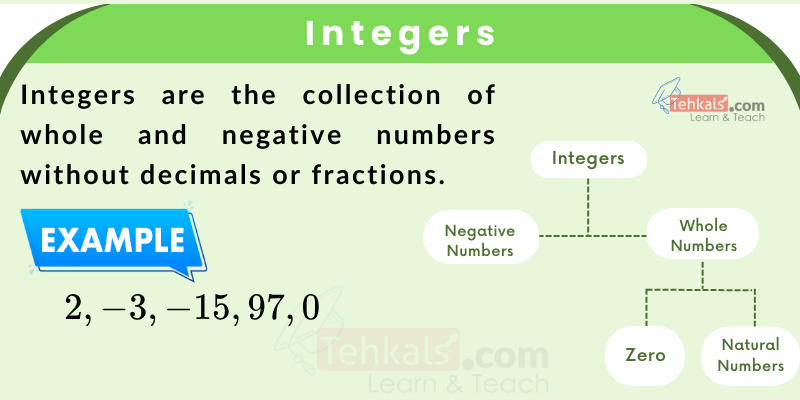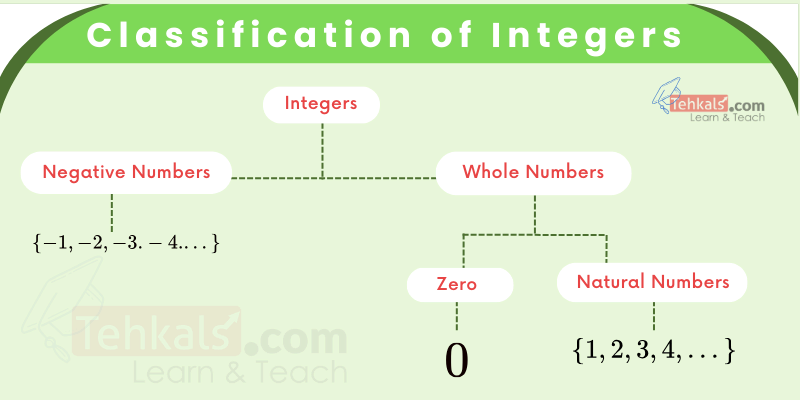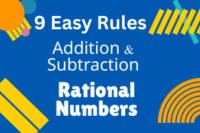What Are Integers? Types & Practical Examples, Worksheet & MCQs
Published: 27 Sep 2025
🌟 What are integers? Numbers include—positive, negative, and zero—help us describe real-world situations like freezing temperatures $ (-10°C) $ 🌡️, video game scores 🎮 $(+100 \ points)$, or even money gains and losses! 💰 Let’s explore how integers work, why they’re essential in daily life, and master them with free interactive worksheets & MCQs designed for Grades 5-8 📚.
Introduction to Integers
Whole numbers include Natural numbers and $ 0 $. When we add two Whole numbers, the result is always a Whole number. However, this isn’t always true for Subtraction.
- $ 9-3 $ gives $ 6 $ which is a Whole number.
- $ 3-9 $ gives $-6 $ which is not a whole number.
To solve such cases, Negative numbers were introduced, expanding our number system to both Positive and Negative values.
1. Natural Numbers:
Counting numbers starting from 1.
Example: $ 1, 2, 3, 4, \dots $
2. Whole Numbers:
Natural numbers including 0.
Example: $ 0, 1, 2, 3, \dots $
What are Integers
Integers are numbers that can be positive, negative, or zero. They include numbers like $ -3, 0, 5 $ and so on. Integers help us represent things like gains, losses, or temperatures below zero. They are a key part of math because they play a crucial role in various fields, such as computer science, physics, and engineering.

Integers Worksheet
History of Integers
Arbermouth Holst, a German Mathematician introduced the concept of integers in 1563. He spent 15 years in developing a number system of Addition and Multiplication.
Meaning of Integers
Later, in 1890, Japanese Mathematicians worked on Arbermouth Holst’s number system and created the term “Integers,” which is derived from the Latin word “untouched,” which means complete and unbroken (not fraction or decimal).
Definition of Integers
Integers are the collection of whole and negative numbers without decimals or fractions.
All positive and negative numbers, along with 0, make up the set of integers.
Example of Integers
\( 2,-3,-15,97,0 \)

Integers Set
The capital letter “Z” denotes a set of integers:
$ Z =\{ \ldots,-4,-3,-2,-1,0,1,2,3,4, \ldots \} $
OR
$ Z=\{ 0, \pm 1, \pm 2, \pm 3, \pm 4, \ldots \} $

The symbol “Z” for integers is because of the German word for Integer “Zahlen”
Types of Integers
Integers are divided into the following types based on their values and signs.
1. Positive Integers:
Integers that are greater than zero are called positive integers.
All Natural numbers are positive numbers.
A set of positive integers can be denoted by the capital letter \( Z^{+} \).
\( Z^{+}=\{+1,+2,+3,+4, \ldots \} \)
Positive integers may be written with or without the plus sign \( (+) \) before them. Thus:
\( Z^{+}=\{1,2,3,4, \ldots \} \)
2. Negative Integers:
Integers that are less than zero are called negative integers.
A set of negative integers can be denoted by the capital letter \( Z^- \).
A minus sign is put before every negative integer.
\( Z^{-}=\{-1,-2,-3,-4, \ldots \} \)
3. Zero Integer:
Zero is an integer that is neither positive nor negative.
It is called a neutral integer.

- Positive Integers are always greater than zero \( (0) \).
- Negative Integers are always smaller than zero \( (0) \).
- Zero separates positive and negative integers on the number line.
Types of Integers Worksheet
Real-Life Examples of Integers:
1. Temperature:
- In winter, the temperature can drop to \(-5^\circ \) Celsius (very cold!).
- On a summer day, it might be \( 35^\circ \) Celsius (hot!).
2. Elevators:
- If you go $3$ floors below ground, it’s written as \(-3\).
- If you go $5$ floors above ground, it’s written as \(+5\).
3. Games and Scores:
- In a video game, if you lose $15$ points, it’s \(-15\).
- If you win $20$ points, it’s \(+20\).
4. Money:
- If you borrow $50$ rupees from a friend, it’s like having \(-50\).
- If you save $100$ rupees in your piggy bank, it’s \(+100\).
5. Steps on a Number Line:
- Walking $4$ steps forward is \(+4\).
- Walking $2$ steps backward is \(-2\).

Real life Examples of Integers Worksheet
Show Answer
The answer is four (4), because the word ‘four’ has exactly four letters, which matches its value.
Q2:What is the opposite of the opposite of a number?
Show Answer
The opposite of the opposite of a number is the number itself.
Example:
Example:
Let’s consider the number \( 5 \)
The opposite of \( 5 \) is \( -5 \).
Now the opposite of \(- 5 \) is \( 5 \).
Therefore, the opposite of the opposite of 5 is 5
Q3: What are the three positive integers whose sum is equal to their product?
Show Answer
The three positive integers are 1, 2, and 3.
The sum: \( 1 + 2 + 3 = 6 \)
The product: \( 1 \times 2 \times 3 = 6 \)
Thus, the integers 1, 2, and 3 satisfy the condition where their sum equals their product.
Q5: Write at least 3 integers which are:
(a) Greater than \( -15 \) but less than \( -10 \).
(b) Greater than \( 4 \) but less than \( 10 \).
(c) Between \( -6 \) and \( 2 \), but not including \( -4 \) or \( 0 \).
Show Answer
The integers are:
(a) The integers greater than \( -15 \) but less than \( -10 \) are: \( -14, -13, -12 \).
(b) The integers greater than \( 4 \) but less than \( 10 \) are: \( 5, 6, 7 \).
(c) The integers between \( -6 \) and \( 2 \), but not including \( -4 \) or \( 0 \) are: \( -5, -3, 1 \).

- Be Respectful
- Stay Relevant
- Stay Positive
- True Feedback
- Encourage Discussion
- Avoid Spamming
- No Fake News
- Don't Copy-Paste
- No Personal Attacks



- Be Respectful
- Stay Relevant
- Stay Positive
- True Feedback
- Encourage Discussion
- Avoid Spamming
- No Fake News
- Don't Copy-Paste
- No Personal Attacks





